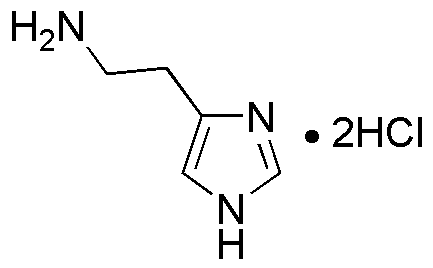Histamine dihydrochloride salt is widely utilized in research focused on:
- Pharmaceutical Research: It serves as a crucial compound in the development of antihistamines and other allergy medications, helping to alleviate symptoms related to allergic reactions.
- Clinical Diagnostics: This compound is used in skin tests to diagnose allergies and hypersensitivity reactions, providing valuable insights for healthcare professionals.
- Neuroscience Studies: Researchers explore its role as a neurotransmitter, aiding in the understanding of various neurological disorders and potential treatments.
- Food Industry: It is used in studies related to food allergies and intolerances, helping manufacturers create safer products for sensitive consumers.
- Pharmacology: The compound is essential for studying the effects of histamine on the cardiovascular system, which can lead to advancements in heart disease treatments.
General Information
Properties
Safety and Regulations
Applications
Histamine dihydrochloride salt is widely utilized in research focused on:
- Pharmaceutical Research: It serves as a crucial compound in the development of antihistamines and other allergy medications, helping to alleviate symptoms related to allergic reactions.
- Clinical Diagnostics: This compound is used in skin tests to diagnose allergies and hypersensitivity reactions, providing valuable insights for healthcare professionals.
- Neuroscience Studies: Researchers explore its role as a neurotransmitter, aiding in the understanding of various neurological disorders and potential treatments.
- Food Industry: It is used in studies related to food allergies and intolerances, helping manufacturers create safer products for sensitive consumers.
- Pharmacology: The compound is essential for studying the effects of histamine on the cardiovascular system, which can lead to advancements in heart disease treatments.
Documents
Safety Data Sheets (SDS)
The SDS provides comprehensive safety information on handling, storage, and disposal of the product.
Product Specification (PS)
The PS provides a comprehensive breakdown of the product’s properties, including chemical composition, physical state, purity, and storage requirements. It also details acceptable quality ranges and the product's intended applications.
Certificates of Analysis (COA)
Search for Certificates of Analysis (COA) by entering the products Lot Number. Lot and Batch Numbers can be found on a product’s label following the words ‘Lot’ or ‘Batch’.
*Catalog Number
*Lot Number
Certificates Of Origin (COO)
This COO confirms the country where the product was manufactured, and also details the materials and components used in it and whether it is derived from natural, synthetic, or other specific sources. This certificate may be required for customs, trade, and regulatory compliance.
*Catalog Number
*Lot Number
Safety Data Sheets (SDS)
The SDS provides comprehensive safety information on handling, storage, and disposal of the product.
DownloadProduct Specification (PS)
The PS provides a comprehensive breakdown of the product’s properties, including chemical composition, physical state, purity, and storage requirements. It also details acceptable quality ranges and the product's intended applications.
DownloadCertificates of Analysis (COA)
Search for Certificates of Analysis (COA) by entering the products Lot Number. Lot and Batch Numbers can be found on a product’s label following the words ‘Lot’ or ‘Batch’.
*Catalog Number
*Lot Number
Certificates Of Origin (COO)
This COO confirms the country where the product was manufactured, and also details the materials and components used in it and whether it is derived from natural, synthetic, or other specific sources. This certificate may be required for customs, trade, and regulatory compliance.


